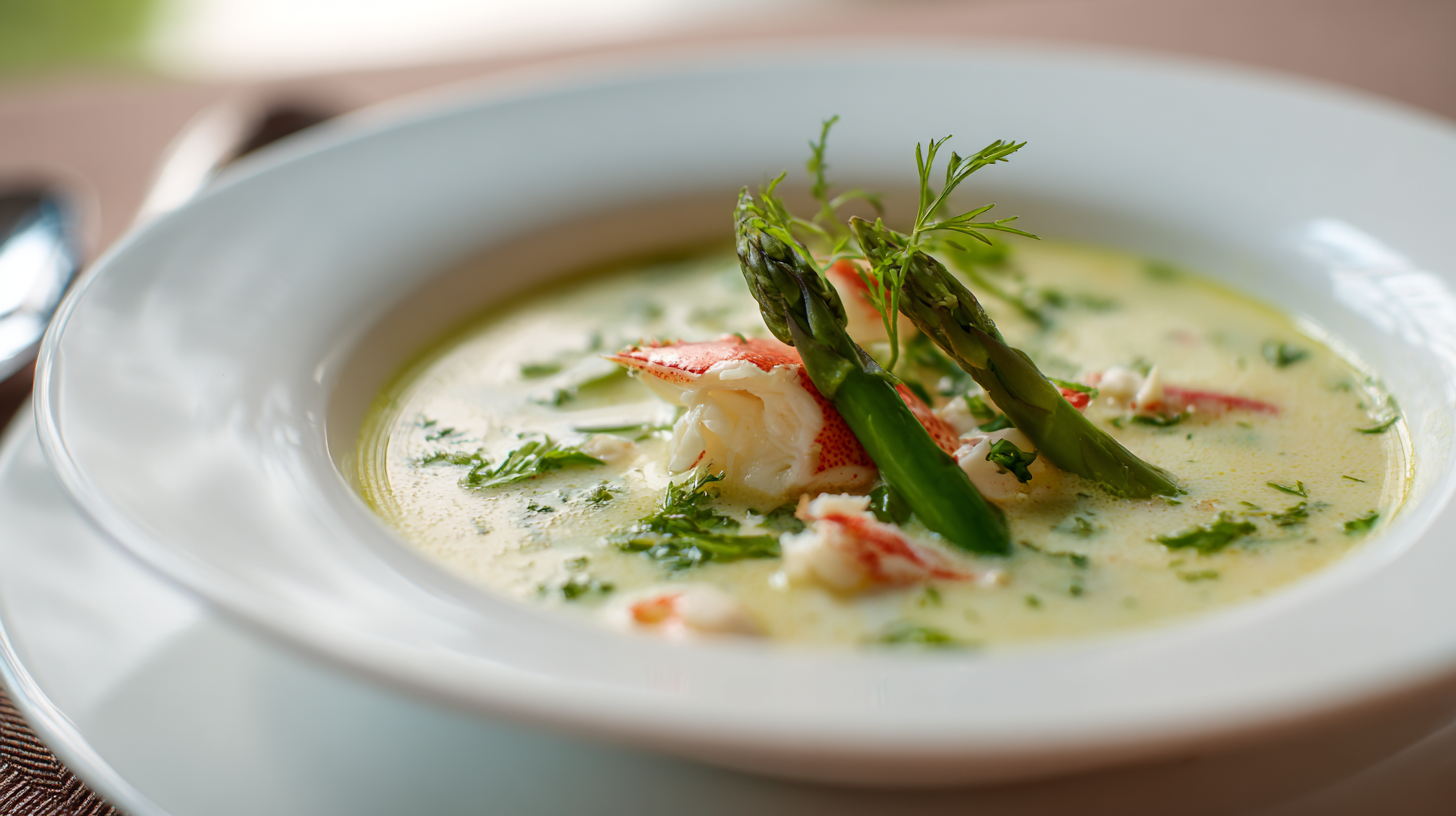Súp Măng Cua, or Vietnamese Crab and Asparagus Soup, is a comforting yet refined dish that holds a special place in Vietnamese celebrations. With its silky broth, tender crab meat, and delicate ribbons of egg whites, this soup is a staple at weddings, banquets, and festive holidays like Lunar New Year. Its elegant simplicity, highlighted by the muted white tones of its ingredients, makes it a standout appetizer for any occasion.
This soup beautifully blends Chinese culinary traditions with Vietnamese flavors, showcasing the influence of French-introduced asparagus. Despite its sophisticated appearance, Súp Măng Cua is surprisingly easy to prepare at home. Whether you’re hosting a special gathering or craving something warm and hearty, this dish delivers a perfect balance of savory richness and light, delicate textures. Every spoonful is a comforting reminder of the joy and warmth found in Vietnamese family celebrations.
What Is Soup Cua?
Soup Cua, also known as Súp Măng Cua, is a traditional Vietnamese Crab and Asparagus Soup that combines delicate flavors with a silky, comforting broth. This dish features tender crab meat, white asparagus, and soft ribbons of egg whites, creating a harmonious blend of textures and tastes.
Originally inspired by Chinese egg drop soup, Soup Cua was later refined by Vietnamese cuisine during the French colonial era, incorporating white asparagus as a key ingredient. Its mild and savory broth is typically made from chicken or pork bones, resulting in a light but flavorful base. Topped with fragrant white pepper and fresh green herbs like cilantro and scallions, the soup is as visually elegant as it is delicious.
This soup is a staple at celebratory events such as weddings, Lunar New Year feasts, and other festive gatherings. Its muted white tones and luxurious crab make it a perfect choice for special occasions, though it is simple enough to enjoy as a comforting meal at home. Despite its sophistication, Soup Cua comes together quickly, usually in under 30 minutes, making it both an accessible and versatile recipe.
Why You’ll Love This Recipe
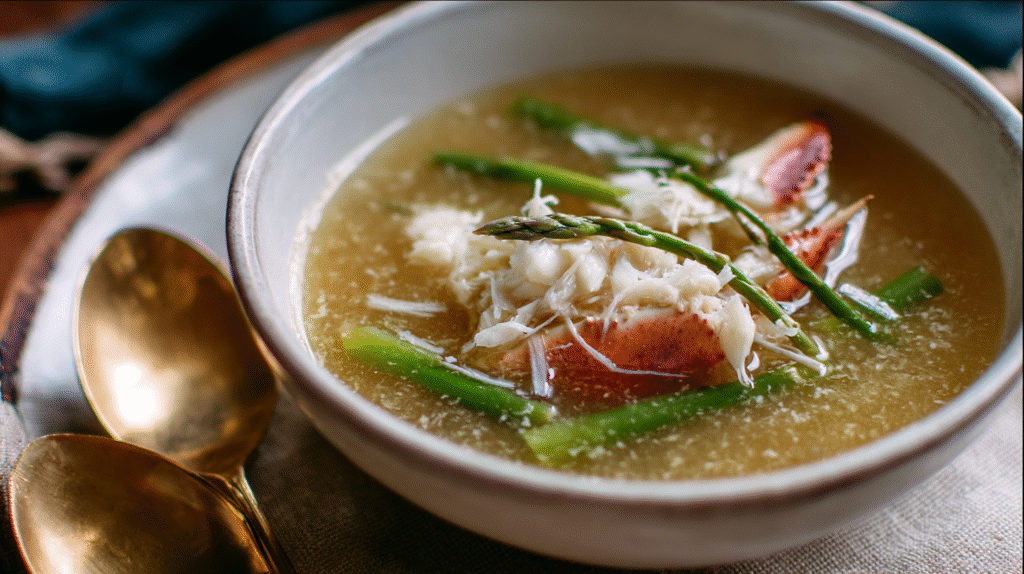
Súp Cua is much more than just a soup; it’s a harmonious blend of simplicity, refinement, and nostalgic warmth. Here’s why this recipe will quickly become one of your favorites:
- Timeless Comfort in Every Bowl: The silky, flavorful broth enriched with tender crab meat and delicate egg ribbons offers a comforting experience perfect for any season. Whether you’re craving something soothing on a chilly evening or looking for a light dish to balance heavier meals, Súp Cua delivers every time.
- Quick and Simple Preparation: This elegant dish doesn’t require hours in the kitchen. With pre-prepared crab meat or minimal processing, you can whip up this soup in under 30 minutes, making it both practical and impressive for weeknights or special occasions.
- Rich Vietnamese Heritage: Cooking Súp Cua connects you to the traditions of Vietnamese family gatherings. Its blend of Chinese and Vietnamese influences, alongside the French-inspired addition of white asparagus, brings diverse culinary worlds together in one pot.
- A Visual and Flavorful Delight: The muted, elegant appearance—silky broth dotted with white pepper and finished with fresh herbs like cilantro and scallions—is as appealing to the eyes as the taste is to your palate. Every spoonful is infused with the savory aroma of chicken or pork stock, making it impossible to resist.
- Customizable for All Tastes: With ingredients like shredded chicken breast, shiitake mushrooms, and asparagus, the recipe is easy to adapt. Add or leave out components to suit your preferences and dietary needs without compromising its delicious essence.
This recipe embodies effortless sophistication, offering a blend of tradition, flavor, and practicality that you’ll adore each time you prepare it.
Tools And Equipment
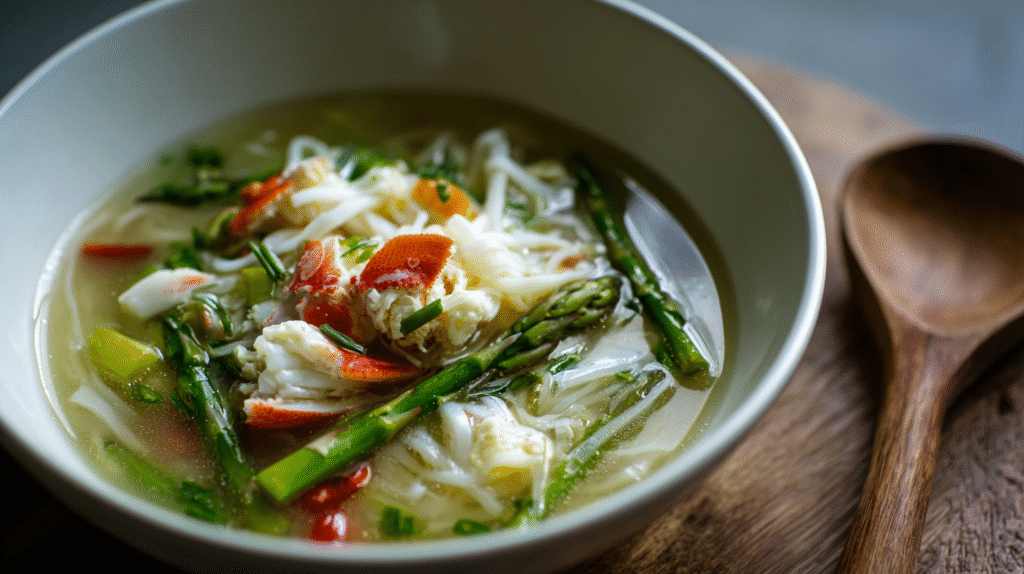
When preparing Súp Măng Cua, having the right tools and equipment is essential for a smooth and efficient cooking process. Here are the key items I recommend:
- Stockpot or Large Cooking Pot: A good-quality stockpot, like those from Le Creuset or Anolon, is a must for boiling the crab and chicken and for assembling the silky base broth. I choose one with a heavy bottom to ensure even heat distribution and prevent scorching.
- Ladle: A sturdy ladle, such as the OXO Good Grips Ladle, is integral for both stirring and serving. I prefer one with a hooked handle so it rests neatly on the pot without slipping into the soup.
- Long-handled Wooden Spoon or Silicone Spatula: Stirring and mixing require precision to maintain the soup’s smooth texture. A wooden spoon from Earlywood or a silicone spatula from GIR works perfectly without scratching the pot.
- Crab Picks or Small Spoon: Extracting the rich, tender crab meat from its shells is easier with crab picks or a small spoon. These tools allow me to get every morsel of flavorful meat for the soup.
These essential tools streamline the preparation process and ensure this elegant Vietnamese crab soup comes together with ease and precision. Each item plays a distinct role, helping me achieve the authentic flavors and texture that make Súp Măng Cua so beloved.
Ingredients

The key to an exquisite Súp Măng Cua lies in its fresh, flavorful ingredients. Below, I’ve outlined everything you’ll need to craft the perfect broth, silky soup, and garnishes.
For The Broth
- Crab: 1 whole crab (about 35 oz) or 7 oz of frozen crab meat.
- Chicken: 7 oz chicken breast for added richness.
- Water: Enough to cover the crab and chicken while boiling.
- Shiitake Mushrooms: 1 oz dried shiitake mushrooms, soaked in water for at least 15 minutes.
- Pork Spareribs: Optional, 4 lbs for a heartier broth.
For The Soup
- Crab Meat: Freshly extracted crab meat from the boiled crab.
- Chicken Stock: 1.5-2 quarts of homemade stock from boiled crab and chicken.
- White Asparagus: 1 can (drained), chopped into bite-sized pieces for a mild sweetness.
- Eggs: 4 medium eggs, beaten for silky ribbons in the soup.
- Tapioca Starch: 10 tbsp, mixed with 6 tbsp of water to create a thickener.
- Seasonings: Salt, soy sauce, fish sauce (optional for added umami), black pepper, and a pinch of sugar.
For The Toppings
- Fresh Herbs: Chopped cilantro and green onions for garnish.
- Black Pepper: Freshly ground, to taste.
Directions
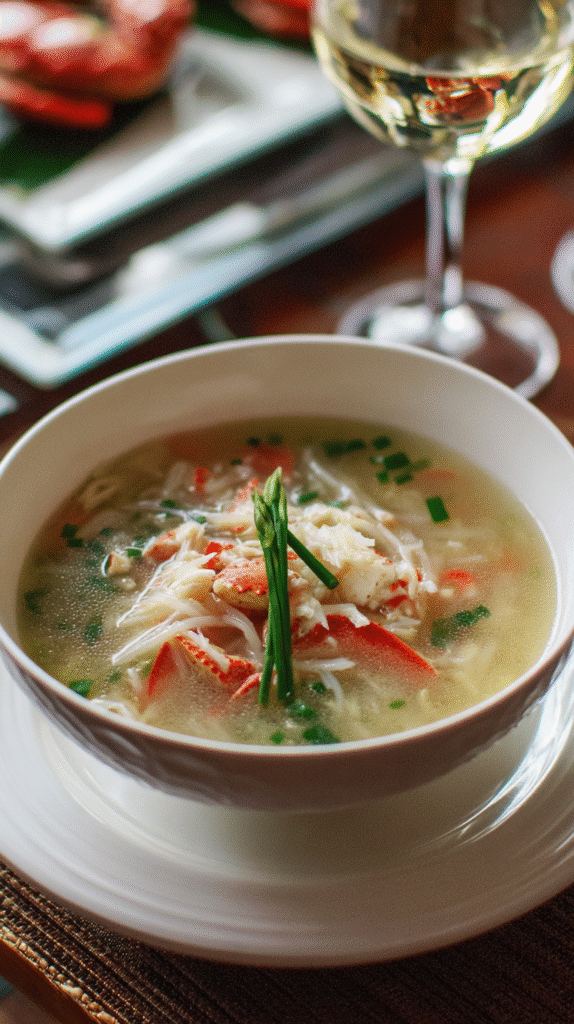
Follow these step-by-step instructions to make a flavorful and silky-smooth Súp Măng Cua. Each step ensures the perfect balance of taste and texture for this beloved Vietnamese dish.
Step 1: Prepare The Broth
- Start with a 3-5 quart pot. Add 12 cups of water and bring it to a boil.
- Parboil 4 pounds of pork spareribs or chicken bones to remove impurities. Boil for 10-15 minutes, then drain and rinse the bones thoroughly.
- Return the cleaned bones to the pot. Add fresh water, onions, shallots, or desired aromatics, and bring everything to a rolling boil.
- Lower the heat to medium-low and let the broth simmer covered for 1 ½ hours. Skim any impurities that rise to the surface periodically.
- Once the broth is ready, strain it to remove solids and set the clear broth aside.
Step 2: Make The Soup Base
- Transfer the broth back to the pot and keep it simmering over medium-low heat.
- Add seasonings such as 2 tablespoons of fish sauce, 1 teaspoon of sugar, 1 teaspoon of chicken bouillon, ½ teaspoon of salt, and a pinch of white pepper. Stir to combine.
- Adjust the seasonings to your taste for a delicate, aromatic yet savory soup base.
Step 3: Add The Crab And Asparagus
- Carefully add 1½ cups of freshly picked crab meat or frozen crab meat directly into the simmering broth.
- Chop white asparagus into 1-to-2-inch pieces (about 1½ cups) and add them to the pot. If you use canned asparagus, drain well before adding.
- Let the crab and asparagus cook for 5-7 minutes, releasing their flavors into the broth.
Step 4: Thicken The Soup
- In a small bowl, dissolve 3 tablespoons of cornstarch or tapioca starch in 1 cup of water to make a slurry.
- Slowly pour the thickening mixture into the soup while stirring continuously in one direction. Allow the soup to simmer for 8-10 minutes until it reaches your desired consistency. Add the thickening mixture gradually, checking for thickness as you go.
- Beat 2 egg whites thoroughly and drizzle them slowly into the soup while stirring gently in a vortex motion to create silky egg ribbons. Let cook for 1-2 minutes until the egg whites are fully set.
Step 5: Garnish And Serve
- Ladle the soup into serving bowls while it is still warm.
- Garnish each bowl with fresh cilantro and chopped green onions. Sprinkle a pinch of ground black pepper on top for added aroma and flavor.
- Serve immediately with a spoon, savoring the warmth and elegance of the soup. Adjust garnishes to suit individual preferences.
Tips For The Best Soup Cua
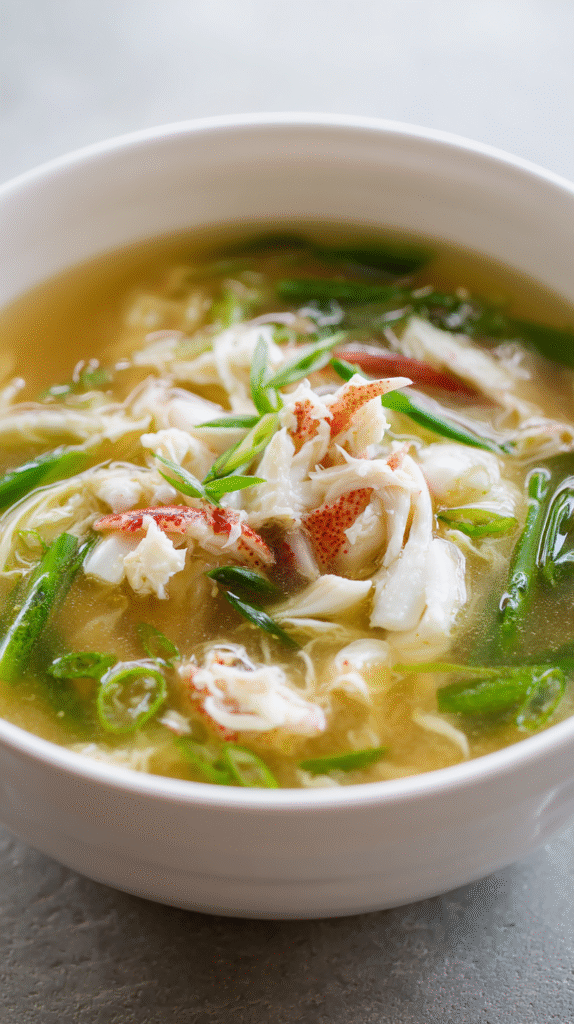
Crafting the perfect Súp Măng Cua requires attention to detail and a few handy tips that elevate the dish from good to exceptional. Over the years, I’ve discovered key insights that ensure this Vietnamese crab soup is always a showstopper.
1. Get the Crab Preparation Right
If you’re using fresh crab, make the most of its natural sweetness. Start by boiling the whole crab in water until it reaches a simmer again. Immediately transfer it to an ice water bath to stop the cooking and preserve the delicate texture of the crab meat. Carefully extract the meat from the shell and claws, ensuring no bits of shell remain. If fresh crab isn’t available, frozen or canned crab meat makes a great alternative, but fresh always elevates the flavor.
2. Choose a Flavorful Broth
A rich and savory broth is the heart of Súp Măng Cua. To achieve the best results, I recommend using the water from boiling the crab and combining it with homemade pork or chicken stock. Pork bone broth provides unmatched depth and sweetness, while chicken stock offers a lighter but equally delicious base. Both options work beautifully, depending on your taste preferences. For added complexity, include aromatics like ginger, onion, and shiitake mushrooms in the broth.
3. Master the Thickening Process
Achieving the soup’s signature silky texture lies in its thickening technique. Mix tapioca starch with cold water to create a slurry, then slowly pour it into the boiling broth while stirring continuously. Adding the slurry gradually ensures smooth, lump-free results. Avoid over-thickening, as the soup should remain delicate and easy to enjoy.
4. Perfect the Egg Whites
The addition of egg whites creates luxurious ribbons in the soup, reminiscent of classic egg drop techniques. Gently drizzle the beaten egg whites into the pot while stirring the broth in a circular motion. This ensures the egg cooks into elegant, thin strands for a refined presentation.
5. Incorporate Fresh, Quality Ingredients
Freshness makes all the difference. I recommend using white asparagus for its tender texture and subtle sweetness. Canned white asparagus can be a convenient substitute, but fresh spears are worth the effort when available. Pair these with ingredients like quail eggs, mushrooms, or even bamboo shoots for added flavor and customization.
6. Don’t Skip the Garnishes
Before serving, finish the soup with freshly chopped cilantro and green onions. A light sprinkle of white pepper enhances the dish’s aromatic appeal. These final touches not only add vibrant color but also enhance the overall flavor, elevating the soup’s comforting and celebratory feel.
7. Adjust to Taste
Every palate is unique, so don’t hesitate to adjust seasonings as needed. Taste the broth throughout the cooking process and add fish sauce, sugar, or salt to balance the flavors to your liking.
By following these tips, your Súp Măng Cua will be perfectly silky, savory, and brimming with authentic Vietnamese flavors every time.
Substitutions And Variations

When making Súp Măng Cua, you can adapt the recipe to suit available ingredients or personal preferences without compromising its flavor and appeal. Below are some practical substitutions and variations I recommend:
Crab Meat Substitutions
Fresh crab meat offers the best flavor and texture for this dish, but alternatives such as canned crab meat or imitation crab meat work well when fresh options are unavailable. Use canned crab meat for convenience, ensuring it is packed in water for a cleaner taste. Imitation crab meat is an economical choice and easy to find, though it has a slightly sweeter flavor.
Asparagus Variations
White asparagus, traditionally used in Súp Măng Cua, may not always be accessible. In such cases:
- Canned White Asparagus: This is the closest alternative. While softer in texture, it blends beautifully into the soup.
- Jarred Asparagus: This can replace canned asparagus but is also softer. Drain before using.
- Green Asparagus: Use this as a fresh twist, but remember to steam it until tender before adding to the soup.
Thickening Agents
The soup’s signature silky consistency typically comes from corn starch. However, you can experiment with:
- Potato Starch: This gives a similar thickening effect, making it a great one-to-one substitute.
- Tapioca Starch: I prefer tapioca starch for its ability to maintain consistency after refrigeration. It also imparts a glossy finish to the soup, enhancing its visual appeal.
These substitutions and variations ensure that this beloved Vietnamese Crab and Asparagus Soup remains versatile, allowing you to enjoy it with ease, no matter the ingredients at hand.
Storage And Reheating Instructions

Proper storage and reheating are key to maintaining the delicate flavors and textures of Súp Măng Cua. Although this soup is best enjoyed fresh, you can store leftovers and reheat them with care to extend its enjoyment.
Storage
- Refrigeration: Once the soup has cooled completely, transfer it to an airtight container. Store it in the refrigerator, where it will stay fresh for up to 5 days. This method preserves the soup’s flavor and texture while keeping it safe to eat during this time frame.
- Freezing: If you need to store the soup for longer, freezing is an option. However, freezing may alter the texture of the crab, asparagus, and egg. To freeze, allow the soup to cool completely, then place it in airtight containers or heavy-duty freezer bags. It can be safely stored in the freezer for up to 3 months.
Reheating
- Microwave: For quick reheating, pour a portion of the soup into a microwave-safe bowl. Heat it in 30 to 60-second intervals, stirring between each interval, until the soup is evenly warmed. Be cautious not to overheat, as this can cause the soup’s texture to degrade.
- Stovetop: To maintain the soup’s silky consistency and delicate textures, reheat it on the stovetop in a small pot. Set the heat to medium and stir the soup frequently while warming. This method ensures even heating and prevents ingredients like the crab and beaten egg from becoming rubbery.
Additional Tips
- Freshness Is Key: Súp Măng Cua tastes best when served fresh, with its contrasting silky broth and tender ingredients intact. If you plan to store it, ensure it is cooled and handled properly to retain these qualities.
- Gentle Handling: As you reheat, stir gently to avoid breaking the delicate crab meat or disrupting the silky ribbons of egg white.
By following these steps, I ensure that my leftover Súp Măng Cua remains as flavorful and appetizing as it was on the first day.
Conclusion
Súp Măng Cua is more than just a dish; it’s a celebration of tradition, comfort, and elegance. Its harmonious blend of flavors and textures makes it a standout recipe for any occasion. Whether you’re honoring Vietnamese heritage or simply craving a warm bowl of goodness, this soup delivers. With its simplicity, versatility, and timeless appeal, Súp Măng Cua is a must-try for every home cook.
Frequently Asked Questions
What is Súp Măng Cua?
Súp Măng Cua is a traditional Vietnamese soup made with crab meat, white asparagus, and egg whites in a silky, savory broth. It is often served during celebrations like weddings and Lunar New Year due to its elegant taste and appearance.
How does Súp Măng Cua reflect Vietnamese culinary traditions?
Súp Măng Cua blends Chinese and Vietnamese traditions, influenced by French cuisine. White asparagus, introduced during colonial times, enhances the soup’s refined appearance, while the flavors and preparation techniques honor Vietnam’s rich culinary heritage.
What are the key ingredients for Súp Măng Cua?
The main ingredients include fresh crab meat, chicken stock, white asparagus, beaten eggs, and tapioca starch for thickening. Seasonings like soy sauce, salt, and pepper, along with fresh garnishes such as cilantro and green onions, complete the dish.
Can I make substitutions for the ingredients?
Yes, substitutions like canned or imitation crab and green asparagus can be used. Potato starch or cornstarch can replace tapioca starch, allowing flexibility without compromising flavor.
How long does it take to prepare Súp Măng Cua?
With the proper preparation and tools, Súp Măng Cua can be made in under 30 minutes, making it a quick yet sophisticated dish for any occasion.
What tools do I need to make Súp Măng Cua?
Essential tools include a stockpot for boiling the broth, a sturdy ladle for stirring, a silicone spatula for mixing, and crab picks or a small spoon for extracting crab meat. These ensure smooth preparation.
How do I thicken the soup properly?
Use a tapioca starch slurry to thicken the soup. Slowly drizzle it into the boiling broth while stirring constantly to achieve the desired silky texture without lumps.
Why does my soup taste bland after adding starch?
Adding starch can dilute flavors. Adjust by seasoning with more salt, soy sauce, or pepper after thickening to enhance the soup’s flavor.
How do I store and reheat Súp Măng Cua?
Refrigerate leftovers in an airtight container for up to 5 days or freeze for up to 3 months. Reheat gently on the stovetop or in the microwave to preserve its texture and taste.
What are the best garnishes for this soup?
Fresh cilantro, green onions, and a sprinkle of white pepper are classic garnishes. They add aroma, a pop of color, and an extra layer of flavor to the soup.
Is Súp Măng Cua suitable for special occasions?
Yes, Súp Măng Cua is a popular choice for celebrations like weddings and Lunar New Year. Its elegant appearance and comforting flavors make it perfect for festive gatherings.
Can I customize Súp Măng Cua for dietary needs?
Yes, the recipe is highly versatile. You can substitute pork-based broth with vegetable stock for a vegetarian version or adjust seasonings for specific dietary preferences.
